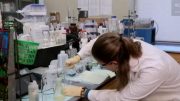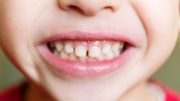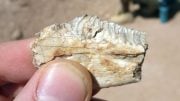Changes within enamel cells point to mechanism by which excessive fluoride leads to fluorosis.
Exposing teeth to excessive fluoride alters calcium signaling, mitochondrial function, and gene expression in the cells forming tooth enamel — a novel explanation for how dental fluorosis, a condition caused by overexposure to fluoride during childhood, arises. The study, led by researchers at NYU College of Dentistry, is published in Science Signaling.
Fluoride is a naturally occurring mineral that helps to prevent cavities by promoting mineralization and making tooth enamel more resistant to acid. It is added to drinking water around the world — the U.S. Department of Health and Human Services recommends a level of 0.7 parts per million — and all toothpastes backed by the American Dental Association’s Seal of Acceptance contain fluoride. The Centers for Disease Control and Prevention (CDC) named water fluoridation one of 10 great public health achievements of the 20th century for its role in reducing tooth decay.
While low levels of fluoride help strengthen and protect tooth enamel, too much fluoride can cause dental fluorosis — a discoloration of teeth, usually with opaque white marks, lines, or mottled enamel and poor mineralization. Dental fluorosis occurs when children between birth and around nine years of age are exposed to high levels fluoride during this critical window when their teeth are forming, and can actually increase their risk of tooth decay. A survey by the CDC found that roughly 25 percent of the U.S. population examined (ages 6 to 49) show some degree of dental fluorosis.
“The benefits of fluoride for oral health considerably outweigh the risks. But given how common dental fluorosis is and how poorly understood the cellular mechanisms responsible for this disease are, it is important to study this problem,” said Rodrigo Lacruz, Ph.D., associate professor of basic science and craniofacial biology at NYU College of Dentistry and the study’s senior author.
To investigate the molecular bases of dental fluorosis, the researchers analyzed the effects of exposing tooth enamel cells to fluoride — levels on the higher end of what you would find in drinking water and consistent with what is found in areas where people commonly have fluorosis. They then assessed fluoride’s impact on calcium signaling within the cells, given calcium’s role in mineralizing tooth enamel.
The researchers found that exposing enamel cells from rodents to fluoride resulted in calcium dysregulation, with decreases in calcium entering and stored in the endoplasmic reticulum, a compartment within cells with many functions, including storing calcium. In addition, fluoride disrupted the function of mitochondria (the cells’ power generators), and therefore energy production was altered. Finally, RNA sequencing — which queries the genomes of cells — revealed that, in enamel cells exposed to fluoride, there was an increased expression of genes encoding endoplasmic reticulum stress response proteins and those encoding mitochondrial proteins, which are involved in producing the cell’s energy.
“This gives us a very promising mechanistic view of how fluorosis arises,” Lacruz said. “If your cells have to make enamel, which is heavily calcified, and due to exposure to too much fluoride the cells undergo continued stress in their capacity to handle calcium, that will be reflected in the enamel crystals as they are formed and will impact mineralization.”
The researchers then repeated the experiment using early-stage kidney cells from humans, but they did not observe the same effects when the kidney cells were exposed to fluoride — suggesting that enamel cells are different from cells forming tissue in other parts of the body.
“You would think that if you expose the enamel cells and kidney cells to the same stressor — treating them with the same amount of fluoride for the same period of time — that you’d have more or less similar responses. But that was not the case,” said Lacruz. “Under the same circumstances, enamel cells react to coping with stress in vastly different ways than kidney cells. We are unraveling a mechanism that highlights the uniqueness of enamel cells and explains why fluorosis is more of a problem in the teeth than anywhere else in the body.”
Reference: “Fluoride exposure alters Ca2+ signaling and mitochondrial function in enamel cells” by Francisco J. Aulestia, Johnny Groeling, Guilherme H. S. Bomfim, Veronica Costiniti, Vinu Manikandan, Ariya Chaloemtoem, Axel R. Concepcion, Yi Li, Larry E. Wagner II, Youssef Idaghdour, David I. Yule and Rodrigo S. Lacruz, 18 February 2020, Science Signaling.
DOI: 10.1126/scisignal.aay0086
In addition to Lacruz, study authors include Francisco J. Aulestia, Johnny Groeling, Guilherme H.S. Bomfim, Veronica Costiniti, and Yi Li of NYU College of Dentistry; Vinu Manikandan, Ariya Chaloemtoem, and Youssef Idaghdour of NYU Abu Dhabi; Axel R. Concepcion of NYU Grossman School of Medicine; and Larry E. Wagner II and David I. Yule of the University of Rochester. This work was funded by the National Institute of Dental and Craniofacial Research (R01DE025639, R01DE027679, and R01DE014756), NYU Abu Dhabi (AD105), and a support grant to NYU Langone’s Laura and Isaac Perlmutter Cancer Center from the National Cancer Institute (P30CA016087).









The American Dental Association and the American Medical Association is a group of CORPORATIONS that want to sell you their stuff. They are NOT looking out for your health, they are looking out for their bottom line.
I leaned how fluoride kills the bacteria that destroy your enamel, yet destroys the enamel itself, in the late 1980s or early 1990s. I stopped using fluoride toothpaste, and my teeth stopped decaying. I had major decay happening fast in my molars. Now I have less decay in the 30 years since, than in the last 3 years that I brushed with fluoride. Then again, I stopped drinking Coca-Cola and other poisonous “soft-drinks” at the same time.